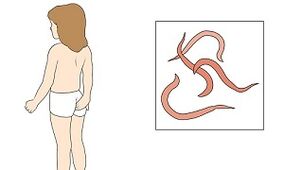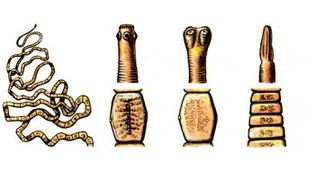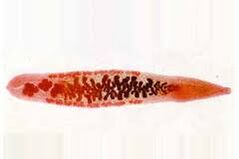Different types of parasites can be in the human body for a very long time and cause very specific health damage.
A significant number of people suffer from serious diseases caused by parasites. At the same time, many have no idea about the presence of pests in the intestines and other organs.
Each species of parasite known to science has its own individual characteristics that an adult should know about.
Risk of infection

At present, science knows more than 200 species of parasites for which the human body is a habitat.
Ways and means of pest penetration into the most favorable habitat have been studied in detail. We can say that each type of parasite has its own "specialization".
Many of the helmets live in the gastrointestinal tract. There are also those that parasitize the liver, lungs and even the brain.
Almost all people are exposed to parasite infestation. It is just as likely that it is an adult or a breastfeeding baby.
A major danger is the presence of parasites in children. First of all, this is reflected in the state of health. Babies often get sick for no apparent reason.
There is a delay in physical and mental development. It is not so easy to identify the cause of the disease, although it often "lies" right away.
It is enough to perform certain studies, identify the type of parasite and prescribe a course of treatment.
A significant number of adults are at risk as their professional activity is associated with the processing of raw materials contaminated with helminths.
Some species of parasites are highly resistant to environmental influences and can be destroyed with great difficulty.
Pest Varieties
The appearance of parasites in the human body is always accompanied by certain signs.
The special feature of this situation is that the symptoms are often very weak and it is difficult to detect the presence of pests without special examinations.

The following types of helminths parasitize the body:
- round;
- tape;
- fluk.
This classification has been made taking into account external features, while parasites of any species have many common features.
Hooks and suction cups in various shapes are designed to make it easier for parasites to secure their position in a particular place.
The life cycle of many parasites consists of several phases. In addition, a species such as a tapeworm has two "owners" - a male and a pet.
Migrated closed loop gives these pests the ability to exist and reproduce. In the process of movement, the parasite enters the human body and feeds on it.
This function is inherent in all microorganisms that live in the intestines or other organs. Only useful species are included in creative activity and parasites are included in destructive activity.
Under these circumstances, humans need to support the beneficial and suppress the pests.
Roundworm
Roundworm includes roundworm. It is a parasite with orange color and without pacifiers.
The spindle shape allows you to migrate through different organs and penetrate the smallest openings and folds. This type of parasite is capable of invading the lungs or pancreas.
The eggs laid by the roundworm are protected by a strong shell that can withstand the destructive effects of hydrochloric acid in the stomach. People are often infected by eating unwashed vegetables and fruits.
Pinworm enters the human body in exactly the same way. Appearance is a thin striped worm of light gray color that grows in length up to 10 mm. Already at the larval stage, the parasite begins to harm humans.

The larva develops into a sexually mature individual and secretes toxic enzymes that irritate the intestinal mucosa.
An adult pinworm is able to penetrate the deep layers of the small intestine and penetrate it. In situations like this, a serious disease called peritonitis develops.
Another round parasite that parasitizes the colon is the whipworm.
The following symptoms appear on ingestion:
- Headache and dizziness
- persistent abdominal pain
- sleep disorder.
Vlasoglav got its name from its external features - the worm is very thin and reaches a length of 50 mm. The parasite is the causative agent of trichocephalosis.
The body never leaves the boundaries - the worm can only be destroyed, after which the parasite comes out with feces.
Tapeworm
The appearance of parasites in humans follows similar scenarios. Pork and cattle tapeworms from the form of tapeworms enter the body when they eat meat, pork and beef, respectively, contaminated by the fins.
These fins or larvae appear to be white bubbles and resemble millet groats.
When they reach the intestines, the larvae anchor and begin to develop into a full-fledged parasite. The development is in most cases asymptomatic.
After about three months, the tapeworm is already able to breed. This type of pest reaches a length of ten meters or more.
The presence of tapeworms in the body causes a serious disease with teniarhinosis. A more serious threat to human health is the Echinococcus type of parasite.

For this parasite, the human body is an intermediate home. The main owners are animals - dogs and cats. People become infected through contact with their beloved animals through the digestive tract - through the mouth.
After reaching the intestines, the eggs begin to develop into larvae, which have six hooks for fixation.
With the bloodstream, they are carried to various organs and are often attached to the liver and lungs.
Growing up, echinococcus begins to destroy the surrounding tissue. Sometimes parasites large enough to be mistaken for a tumor.
Alveococcus is another representative of the banded parasite in the human body. After penetration into the intestine, the larvae develop intensively and penetrate the walls of the small intestine and are carried by the bloodstream to various organs and systems.
Like echinococcus, the parasite is trapped in the liver and begins its destructive activity.
The blood supply to the liver tissue is disrupted, necrosis begins, posing a serious danger to human health and even life.
Fluke Worms
The list of tapeworms contains a separate species of parasite called flukes.
The following species are particularly dangerous flukes:
- cat curse;
- fasciola;
- schistosoma.

Liver pathologies are more common among human diseases than other organ diseases. Flukes got their name from their anatomical structure.
There are several suction cups on the parasite's body, by means of which the pest holds a specific place and penetrates deep into living tissue.
Feline fluke is most commonly found in the gallbladder and pancreas.
Fluke enters the human body along with fish that are not sufficiently salted or cooked.
In humans affected by this pest, the temperature rises sharply, an unreasonable cough appears and rashes appear on the body. If you do not take emergency measures, the person may die.
Fasciola is absorbed into the body by drinking unboiled water. With the patient's knowledge, it causes chronic jaundice.
Schistosomiasis, which is caused by a rare parasite, has become more common in recent years.
This fact is explained by the fact that a large number of people started visiting tropical countries where this pest is widespread.
Preventive measures
Medical practice shows that parasites rot in the intestines much more often than in other organs.
Pests of various types are able to adapt to exist in the liver, lungs, heart, brain and even in the eyes - only this list provides a sufficient idea of the danger parasites pose to human health and full life.

Different types of parasites can enter the body both individually and in combination, increasing the severity of the lesion.
To prevent pests of any kind in your body, it is enough to follow the basic rules of hygiene and hygiene requirements for food.
Young children should be kept under constant supervision, especially in summer when traveling to land or sea.
Today, there is no need to eat raw meat or fish, including stroganin. This atavism must remain forever in the past so as not to expose your body to unwarranted risk.
















































